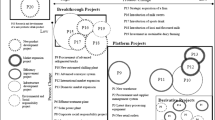Abstract
In an ever-increasing competitive business environment, it has become increasingly important to be able to obtain efficient and sustainable business operations not only by efficient core procedures but also by being able to minimise losses incurred by risk taking. The latter by handling both operational risks and financial risks in a unified model. This is important not least in businesses that handle sets of simultaneous large projects, which is the topic of risk handling in project portfolios. In this paper, we present a novel method for business risk handling for project portfolios under strong uncertainty. The method is based on event trees representing each adverse consequence modelled, together with mitigation costs and effects. The aggregation of all consequences for all projects together constitutes the risk portfolio for the business. This method is used in one of Sweden’s largest manufacturing enterprises having a vast portfolio of projects in the form of ongoing tenders for orders.
Access this chapter
Tax calculation will be finalised at checkout
Purchases are for personal use only
Similar content being viewed by others
Notes
- 1.
The two-point uniform and trapezoid distributions have λ = 0.
- 2.
Refer to any textbook on statistics for particulars, such as [17].
- 3.
Let y = cdf(x, R) be the cumulative probability for the cost x for the project risk R. Then the inverse x = cdf−1(y, R) yields the risk exposure limit for the risk level y. Let mean(R) be the mean cost for the project risk R. Then the following is a risk measure for y > 0.75:
t(y, r) = (cdf−1(y, R) + mean(R))/2
The net gain measure for a mitigation M (with mitigation cost m(M)) compared to an unmitigated R at the risk level y is gain(y, R, M) = (t(y, R) − t(y, M))/m(M) − 1 if m(M) > 0.
- 4.
The expected cost is not the crossover at 50% CDF since it is asymmetric.
References
Abdo, H., Flaus, J.M.: Uncertainty quantification in dynamic system risk assessment: a new approach with randomness and fuzzy theory. Int. J. Prod. Res. 54(19), 5862–5885 (2016)
ALARP Guidance Note, Commonwealth Offshore Petroleum and Greenhouse Gas Storage (Safety) Regulations 2009. NOPSEMA (2015)
Aven, T., Zio, E.: Some considerations on the treatment of uncertainties in risk assessment for practical decision making. Reliab. Eng. Syst. Saf. 96, 64–74 (2011)
Azzalini, A.: A class of distributions which includes the normal ones. Scand. J. Stat. 12, 171–178 (1985)
Clemens, P.L., Simmons, R.J.: System safety and risk management. NIOSH instructional module. In: A guide for Engineering Educators. National Institute for Occupational Safety and Health, Cincinnati, Ohio, IX–3 – IX–7 (1998)
Danielson, M., Ekenberg, L., Larsson, A.: Distribution of expected utility in decision trees. Int. J. Approx. Reason. 46(2), 387–407 (2007)
Danielson, M., Ekenberg, L.: A Method for Decision and Risk Analysis in Probabilistic and Multiple Criteria Situations. U.S. Patent No. 11/145229 (2004)
Danielson, M., Ekenberg, L., Larsson, A., Riabacke, M.: Weighting under ambiguous preferences and imprecise differences in a cardinal rank ordering process. Int. J. Comput. Intell. Syst. 7(1), 105–112 (2014)
Dubois, D.: Representation, propagation, and decision issues in risk analysis under incomplete probabilistic information. Risk Anal. 30(3), 361–368 (2010)
Dutta, P.: Human health risk assessment under uncertain environment and its SWOT analysis. Open Public Health J. 11, 72–92 (2018)
Golenko-Ginzburg, D.: Controlled alternative activity networks in project management. Eur. J. Oper. Res. 37, 336–346 (1988)
Huang, L.: The failure-tree analysis based on imprecise probability and its application on tunnel project. Chem. Eng. Trans. 59, 463–468 (2017)
Johnson, W.G.: MORT – The Management Oversight and Risk Tree. SAN 821-2, U.S. Atomic Energy Commission (1973)
Kendall, M.G., Stuart, A.: The Advanced Theory of Statistics. Volume 1: Distribution Theory, 3rd edn. Griffin (1969)
Kjellén, U., Tinmannsvik, R.K.: SMORT: Säkerhetsanalys av industriell organisation. Stockholm:Arbetarskyddsnämnden, in Swedish (1989)
Kletz, T.: Hazop and Hazan, Notes on the Identification and Assessment of Hazards. Institution of Chemical Engineers, Rugby (1974)
Loeve, M.: Probability Theory. Graduate Texts in Mathematics, vol. 45, 4th edn. Springer, Heidelberg (1977). https://doi.org/10.1007/978-1-4684-9464-8
Neal, R.A.: Modes of Failure Analysis Summary for the Nerva B-2 Reactor. Westinghouse Electric Corporation Astronuclear Laboratory. WANL–TNR-042 (1962)
Nielsen, D.S.: The cause consequence diagram method as a basis for quantitative accident analysis. Report Risö-M-1374. Risö National Laboratory, Denmark (1971)
O’Hagan, A., Leonhard, T.: Bayes estimation subject to uncertainty about parameter constraints. Biometrika 63, 201–202 (1976)
Owen, D.B.: Tables for computing bivariate normal probabilities. Ann. Math. Stat. 27, 1075–1090 (1956)
Rohmer, J., Baudrit, C.: The use of the possibility theory to investigate the epistemic uncertainties within scenario-based earthquake risk assessments. Nat. Hazards 56, 613–632 (2010)
Shapiro, A.F., Koissi, M.C.: Risk assessment applications of fuzzy logic. Casualty actuarial society, Canadian Institute of Actuaries, Society of Actuarie (2015)
Acknowledgements
This research was partly funded by strategic grants from the Swedish government within ICT – The Next Generation.
Author information
Authors and Affiliations
Corresponding author
Editor information
Editors and Affiliations
Rights and permissions
Copyright information
© 2018 Springer Nature Switzerland AG
About this paper
Cite this paper
Danielson, M., Ekenberg, L. (2018). Efficient and Sustainable Risk Management in Large Project Portfolios. In: Zdravkovic, J., Grabis, J., Nurcan, S., Stirna, J. (eds) Perspectives in Business Informatics Research. BIR 2018. Lecture Notes in Business Information Processing, vol 330. Springer, Cham. https://doi.org/10.1007/978-3-319-99951-7_10
Download citation
DOI: https://doi.org/10.1007/978-3-319-99951-7_10
Published:
Publisher Name: Springer, Cham
Print ISBN: 978-3-319-99950-0
Online ISBN: 978-3-319-99951-7
eBook Packages: Computer ScienceComputer Science (R0)




